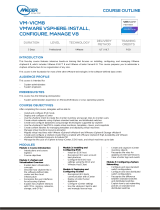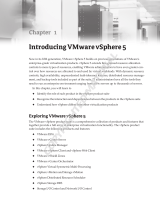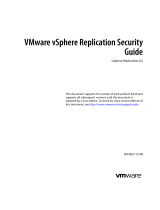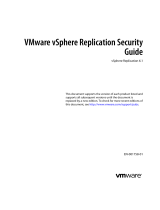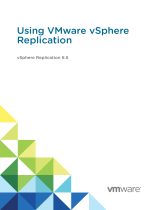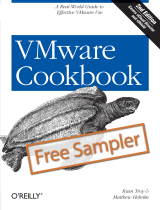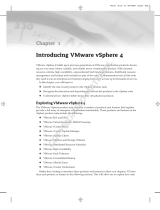Page is loading ...

Technical Report
EqualLogic Virtual Storage Manager:
Installation Considerations and
Datastores Manager
Abstract
This technical report discusses the
features of the VSM Datastores Manager
and VASA Provider and focuses on a
number of concepts that a user should
consider prior to installation.
TR1067
v1.0


Copyright © 2012 Dell Inc. All Rights Reserved.
EqualLogic is a registered trademark of Dell Inc.
Dell is a trademark of Dell Inc.
All trademarks and registered trademarks mentioned herein are the property of
their respective owners.
Information in this document is subject to change without notice.
Dell Inc. will not be held liable for technical or editorial errors or omissions
contained herein. The information in this document is subject to change.
Reproduction in any manner whatsoever without the written permission of Dell
is strictly prohibited.
Authored By: David Glynn
January 2012
WWW.DELL.COM/PSseries

iii
Preface
PS Series arrays optimize resources by automating performance and network load
balancing. Additionally, PS Series arrays offer all-inclusive array management software,
host software, and free firmware updates.
Audience
The information in this guide is intended for VMware vCenter administrators and PS
Series SAN administrators.
Related Documentation
For detailed information about PS Series arrays, groups, volumes, array software, and
host software, log in to the Documentation page at the customer support site.
Dell Online Services
You can learn about Dell products and services using this procedure:
1. Visit http://www.dell.com or the URL specified in any Dell product information.
2. Use the locale menu or click on the link that specifies your country or region.
Dell EqualLogic Storage Solutions
To learn more about Dell EqualLogic products and new releases being planned, visit
the Dell EqualLogicTechCenter site: http://delltechcenter.com/page/EqualLogic. Here
you can also find articles, demos, online discussions, technical documentation, and
more details about the benefits of our product family.
For an updated Dell EqualLogic compatibility list please visit the following URL:
https://support.equallogic.com/compatibility

iv

v
Table of Contents
Revision Information ............................................................................................................................ vi
Executive Summary ................................................................................................................................ 1
Introduction ................................................................................................................................................ 1
Installation Considerations: ............................................................................................................... 2
vCenter Server Managed IP requirement .......................................................................... 2
Protecting the VSM virtual appliance ................................................................................... 3
Connecting to the Storage Network .................................................................................... 4
Installation .................................................................................................................................................. 5
Installation Process ........................................................................................................................ 7
Post-install Configuration ........................................................................................................ 14
Configuring the VASA Provider .................................................................................... 14
Changing the root account password ...................................................................... 16
Adding a second NIC to the VSM ................................................................................ 16
Virtual Storage Manager Overview .............................................................................................. 18
Datastores Manager Overview .............................................................................................. 18
Launching VSM ..................................................................................................................... 19
Connecting to EqualLogic storage ............................................................................. 21
Create a datastore or multiple datastores ..............................................................22
Increase the size of a datastore .................................................................................... 27
Deleting a datastore ........................................................................................................... 29
Creating an ACL policy .....................................................................................................30
VASA Provider ...........................................................................................................................3536
Summary .............................................................................................................................................. 3738
Appendix .............................................................................................................................................. 3839
Appendix A: Upgrading HIT/VE 3.1 to VSM 3.5 ....................................................... 3839
Technical Support and Customer Service ......................................................................... 4243

vi
Revision Information
The following table describes the release history of this Technical Report.
Report
Date
Document Revision
1.0
January 2012
Initial Release
The following table shows the software and firmware used for the preparation of this Technical
Report.
Vendor
Model
Software Revision
Dell
PS Series SAN
5.2 or higher, 6.x
VMware
vSphere vCenter
5.0 and 5.1
VMware
vSphere ESX/ESXi
4.1
1
, 5.0 and 5.1
Dell
Virtual Storage Manager
3.5
Note:
1
vSphere ESX/ESXi 4.1 is supported when managed by vSphere vCenter 5.0 or above.
The following table lists the documents referred to in this Technical Report. All PS Series
Technical Reports are available on the Customer Support site at:
support.dell.com
Vendor
Document Title
Dell
TR1076: Virtual Machine Protection with Dell EqualLogic Virtual Storage
Manager v3.5

1
Executive Summary
This technical report is aimed at VMware™ and Dell™ EqualLogic™ PS Series
SAN administrators to guide them on the installation and usage of the Dell
Virtual Storage Manager v3.5. This technical report will focus on understanding
considerations around installation of VSM, and highlighting the functionality
that is provided by the Datastores Manager component of the VSM plugin.
Additional technical reports will cover the other feature of VSM.
Introduction
In today’s Datacenters, customers are using VMware™ virtualization solutions
and Dell™ EqualLogic™ PS Series SAN storage to consolidate servers and
storage for better utilization, efficiency and ease of management. The
encapsulation of a Virtual Machine (VM) into a set of files increases both the
flexibility of data protection as well as the challenges of managing the
protection of all these virtualized assets. VMware utilizes a snapshot
technology within vCenter that can quiesce and help protect these VMs. Dell
has combined the intelligence of native point-in-time PS Series SAN snapshots
with these vCenter snapshots to provide a scalable and automated data
protection package for the virtual environment.
The Dell Virtual Storage Manager v3.5 (VSM) is the next generation of VMware
vCenter plug-ins that allows administrators to coordinate data protection and
recovery within their virtual environment. The Dell VSM is a virtual appliance
that is downloaded as part of the all-inclusive Dell EqualLogic software support
and can be installed into an existing VMware vCenter environment. VSM
contains many tools and capabilities that help VMware administrators gain
better control and functionality over their EqualLogic environment including:
• Datastores Manager - a tool to provision, expand, delete and monitor
EqualLogic Datastores across multiple EqualLogic groups.
• VSM Smart Copies and Replication - formerly known as Auto-Snapshot
Manager/VMware, this tool allows the creation of hypervisor-consistent
snapshots, clones and replicas for data protection and disaster recovery
• VDI Tool - a tool which coordinates SAN based thin cloning to provision
space efficient virtual desktops within a VMware View environment
• Dell EqualLogic VASA Storage Provider - a set of tools that allow vCenter
and the EqualLogic SAN to communicate for better storage awareness

2
Installation Considerations:
While the installation process for Virtual Storage Management v3.5 is
straightforward, to insure a smooth installation, there are a few considerations
that should be taken into account, and prerequisite that should be completed.
vCenter Server Managed IP requirement
The installation process for Virtual Storage Management v3.5 has been
significantly streamlined over prior versions, with most of the configuration
been done during the import of the VSM virtual appliance.
One of the settings that is populated automatically is the vCenter IP address.
This is pulled from querying the vCenter into which the VSM virtual appliance is
being installed, and is dependent upon the vCenter Server Managed IP address
field being populated, as shown below.
To verify, or set the vCenter Server Managed IP:
1. From the vCenter client file menu, click on Administration, then vCenter
Server Settings.
2. From vCenter Server Settings select Runtime Settings.
3. Verify or enter the vCenter Server’s IP address in the vCenter Server
Managed IP field.
4. Click OK to apply.

3
Protecting the VSM virtual appliance
Care should be exercised when selecting which datastore to host the virtual
machine that is the Virtual Storage Management appliance. While VSM can be
placed on a datastore that is being replicated or snapshotted by the array, it
should
not
be placed on a datastore whose replication is being managed by
VSM or that is being Smart Copied by VSM. This is because of the quiescing that
is performed as part of these operations may disrupt the VSM while it is
managing the replication or Smart Copy task.
As VSM is an integral part of a visualized environment data protection strategy,
consideration needs to be given to protecting it. Use the vSphere High
Availability feature to provide continued availability of VSM in the event of host
failure. For more serious failures it may be necessary to re-install the VSM. The
critical data that VSM contains exists in an internal database, of which a locally
stored backup is automatically created daily. This database backup can be
accessed via the VSM’s CIFS share, \\<IP Address or Hostname>\
database\dbbackup.sql, and should be copied or backed up to another location.
This database backup file, coupled with a newly installed instance of VSM, will
quickly restore a corrupted or accidently deleted VSM to a working state as
detailed below.
1. Install VSM following the instructions in Installation section of this
technical report.
2. Browse to the VSM’s CIFS share, \\<IP Address or Hostname>\ database\
and copy in the backup copy of the database. The backup filename must
begin with dbbackup and have an extension of .sql.
3. Launch the VM console for the VSM virtual appliance and log into the
VSM console.
4. From the menu select Maintenance, and then Database Restore.
5. The console will then display all of the database backups in the backup
folder, select the appropriate backup and press enter. VSM will then begin
the process of restoring the database backup.
Note: Depending on the amount of data in the backup, it can take several
minutes for the restore to complete.
6. Once the database restore operation is completed, the state of VSM will
have been restored, include its knowledge and snapshots and replicas
that it created on the EqualLogic array.

4
Connecting to the Storage Network
Virtual Storage Manager must communicate with vCenter and the EqualLogic
PS Series array, and if using the VDI tool, also with the VMware View server. The
default method for communicating with an EqualLogic PS Series array is the
Group IP; however the Group IP exists on the iSCSI network, which is often kept
isolated from the rest of the networking environment.
There are three options for enabling communications with the EqualLogic
group:
1. Create an exception in the router isolating the iSCSI network to permit
traffic from VSM to be passed.
2. In virtualized environment, there is frequently a need for guest OSes to
directly access the storage. This is done to enable these guest OSes to
use tools such as EqualLogic Auto Snapshot Manager for Windows and
Linux to offer data protect to such applications as Exchange and SQL. In
such cases the design of the virtualized environment’s virtualized
networking will include a VM network with access to the iSCSI network.
3. Enablement of the dedicated EqualLogic management network. This
enables access to the EqualLogic’s array management functions, but
maintains the preferred isolation of the iSCSI network. For details on
enabling the management network see the About Dedicated
Management Networks section of the firmware’s Group Manager
Administrator’s Manual.
Note: Option 1 does not require a second NIC in the VSM. Option 2 does
require a second NIC in the VSM. Option 3 may require a second NIC in the
VSM depending on upon the environments network configuration.
See the section titled Adding a second NIC to the VSM in the Post-install
Configuration section.

5
Installation
The Dell EqualLogic Virtual Storage Manager v3.5 is delivered as a virtual
appliance packaged in an OVA (Open Virtual Machine Format - Archive). The
installation process is similar to that of other virtual appliances, with
administrator entering typical information such as Name and Location; several
additional properties are also requested that simplify and minimize the post-
install configuration of VSM.
During the installation process a number of key pieces of information are
required. The table below lists these:
Option
Description
Value
Name
Name for the VSM virtual appliance as it is
to appear in the vCenter inventory.
Inventory location
Specifies the datacenter within vCenter
that the VSM virtual appliance will reside,
and optionally an inventory folder
1
.
Cluster or Host
1
Specifies the cluster and depending upon
the cluster’s DRS setting, the specific host,
that the VSM virtual appliance will be
deployed.
Resource Pool
1
Specifies, if utilized, the cluster’s resource
pool that VSM virtual appliance should
consume CPU and memory resource from.
Datastore
Location where the virtual appliances files
will reside. Optionally a VM Storage Profile
1
can be assigned at this point.
Disk Format
A virtual machine’s disk, or VMDK, can be of
one of three types: Thick Provisioned Lazy
Zero, Thick Provisioned Eager Zeroed, or
Thin Provisioned. While a thick provisioned
format is recommended, it is not required.

6
Network Mapping
The VM network to connect the VSM’s
network interface to.
Host Name
The network name by which the VSM
virtual appliance is to be known by.
Time Zone
The time zone of the environment in which
the VSM virtual appliance is located.
NTP Servers
Comma-separated list of NTP servers that
can be synched with.
vCenter username
The username of the account with which
VSM will communicate with vCenter.
vCenter password
Password for the above user account.
Default gateway
The default gateway used for network
access.
DNS
Comma-separated list of DNS servers used
to resolve hostnames.
IP address
The IP address to be used by the VSM
virtual appliance network interface.
Netmask
The network mask to be used by the VSM
virtual appliance network interface.
1
Depending upon the configuration of the environment, these settings may not
be required, or may not require user input.

7
Installation Process
1. From the vSphere Client file menu select File, and then Deploy OVF
Template.
2. Click on the Browse button, and using the Windows Explorer window
browse to the location when the OVA was downloaded or copied to.
Select the VSM OVA file and click Open. With the VSM OVA selected,
click Next to continue.

8
3. The OVF Template Details page displays additional information of the
VSM virtual appliance. Click Next to continue.
4. The End User License Agreement, or EULA, is two pages long, with the
first pages been utilized to remind administrators of the requirement to
have the vCenter Server Managed IP field populated in vCenter Server
Settings. Click Accept to continue.
The second EULA page contains the End User License Agreement for the
Dell EqualLogic Virtual Storage Manager. Click Accept to continue.

9
5. Specify a name for the VSM virtual appliance; this is the vCenter display
name, and not the network hostname. Also specify the inventory
location, which datacenter and which inventory folder, for the VSM
virtual appliance.
6. Select the Cluster that the VSM virtual appliance will be located in.
Depending upon the cluster’s DRS setting it may be necessary to select
an individual host.
7. Also depending upon the cluster’s settings, there may be the opportunity
to select a Resource Pool for the VSM virtual appliance. Select the
resource pool and click Next to continue.

10
8. Select a suitable datastore where the VSM files will be located. Refer to
Datastore considerations and protecting the VSM virtual appliance for
considerations that should be taken into account when selecting a
suitable datastore.
Depending upon the environment, business needs, and license
availability, there may be an option to assign a VM Storage Profile to the
virtual appliance. Click the drop down and select the appropriate Storage
Profile. Click Next to continue.
9. Select the Disk Format. Best practice is to choose a disk format of type
Thick be selected in all but test & development environments, however,
all formats are supported in production environments. Click Next to
continue.

11
10. Select the appropriate VM network for the VSM virtual appliance to
connect to. If the network in the environment is configured so that the
EqualLogic array is isolated from this VM network, a second network
interface can be added later. See the section Adding a second NIC to
the VSM for more details. Click Next to continue.

12
11. On this page most of the settings that VSM will require are configured.
Refer to the Table XX for an explanation of each of the individual fields.
Complete the ones that are necessary for this environment and click
Next to continue.

13
12. This final page will display a summary of the settings chosen though the
OVF/OVA import process. Check the Power on after deployment
checkbox to have the virtual appliance power up once the import
process is complete. Click Finish to start the import process.
13. The import process will take several minutes to complete, depending
upon the network connection speed. Once the import is complete the
VSM virtual appliance will power on. The first boot of the VSM virtual
appliance takes several minutes as it completes a number of first boot
tasks, and registers with vCenter.
/
